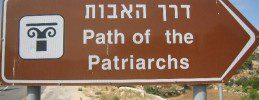Visiting the Way of the Patriarchs in Gush Etzion
July 29th 2013
 The Way of the Patriarchs (Derech HaAvot), the ancient route linking Hebron to Jerusalem, is located between the communities of Neve Daniel and Alon Shvut in the Gush Etzion area of Judea. The path is believed to be the one that the Biblical patriarchs Abraham, Isaac and Jacob used when traveling between Hebron and Mount Moriah, which would eventually become the spiritual heart of Jerusalem.
The Way of the Patriarchs (Derech HaAvot), the ancient route linking Hebron to Jerusalem, is located between the communities of Neve Daniel and Alon Shvut in the Gush Etzion area of Judea. The path is believed to be the one that the Biblical patriarchs Abraham, Isaac and Jacob used when traveling between Hebron and Mount Moriah, which would eventually become the spiritual heart of Jerusalem.
Hebron is believed to be the oldest Jewish community in the world. When the Patriarch Abraham first entered ancient Israel, he settled in Hebron. King David was anointed there and ruled from Hebron for seven years, before moving his capital to Jerusalem.
South of Jerusalem, among the Judean hills, lies a cluster of 22 communities that are collectively referred to as Gush Etzion. Popular among English-speaking immigrants to Israel, the oldest communities in Gush Etzion were founded a few decades prior to the establishment of the State of Israel in 1948.
Travel between Hebron and Jerusalem first became important on a mass scale during the time when the First and Second Holy Temples stood in Jerusalem. Three times a year, residents from all over Israel traveled to Jerusalem for the pilgrimage festivals, and the Way of the Patriarchs is believed to be the road used by residents who lived south of Jerusalem. The highlights of the Path of the Patriarchs today are a Roman milestone marker, a mikvah (ritual bath) and the Biyah Aqueduct.
The Roman milestone marker marks a distance of 12 Roman miles (approximately 10 miles) from the Damascus Gate of the Old City of Jerusalem. It is believed that the Romans who ruled in Israel after the destruction of the Second Temple used this same road.
Another highlight is the mikvah which dates from the Second Temple period. Scholars posit that this mikvah was used by travelers seeking to purify themselves on their way to Jerusalem for the three annual pilgrimage festivals.
Nearby is the Biyar Aqueduct, which was used to transport water to Jerusalem, also during Second Temple times. If you decide to descend into the Biyar Spring and aqueduct to explore the ancient water system, expect to get wet and muddy.
When hiking on The Path of the Patriarchs, make sure to wear comfortable shoes, bring along food and drink – plus a flashlight, water shoes and a change of clothes if you are going to enter the water tunnels at the Biyar Aqueduct.











